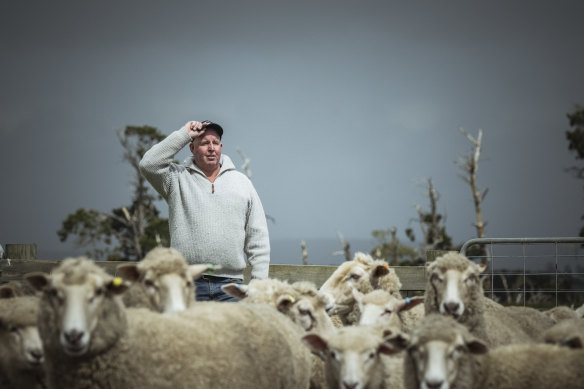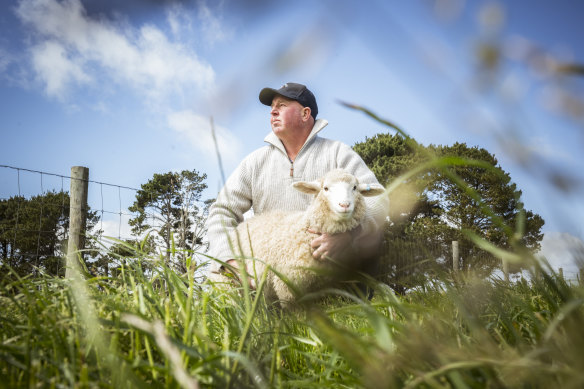By Mike Foley
Some farmers are resorting to offering their sheep for free to whoever will take them, as livestock prices plummet ahead of a forecast dry summer they fear could strip paddocks bare.
Nearly three years of good rainfall on the eastern seaboard filled paddocks with feed and farmers eagerly rebuilt their flocks after the preceding drought decimated livestock numbers.

Victorian farmer Scott Young is concerned about the decrease in lamb prices.Credit: Chris Hopkins
That meant fewer lambs and sheep were sent to abattoirs, and the resulting high demand created a favourable market for farmers who were receiving about $9 a kilo for lamb.
But with the switch to an El Nino weather system, which is linked to drought and bushfires in eastern Australia, many farmers are rushing to the saleyards.
The glut of livestock has pushed prices down towards $4 a kilogram for lamb.
Leonard Vallance, who produces sheep in the Mallee region of north-west Victoria, said the low price was forcing tough decisions for some farmers who needed to offload stock.
“It’s absolutely devastating, that’s all you can say. It’s catastrophic,” Vallance said. “You can’t freight them to the saleyard for that price, [$4 a kilogram] so you might as well give them away.”
Jenny Bradley, a grazier from Armatree in Central West NSW, said a small group of farmers who were most affected had offered to offload sheep for free.
“It is an extreme end of the industry and it’s an extreme offer. But it has been offered, and the uptake hasn’t been very large, I believe.”
The Bureau of Meteorology’s Climate Outlook last Thursday forecast that below-median rainfall was likely for much of western, northern and southern Australia between November and January. It also said maximum temperatures were at least twice as likely to be unusually warm across the country.

Young has urged farmers to hold on to their stock to take some pressure out of the market.Credit: Chris Hopkins
Victorian livestock and grain farmer Scott Young said many farmers were alarmed at the weather forecast, but the long-term outlook was far from certain. He advised producers who didn’t have to offload stock that it could make sense to wait and see how 2024 played out.
“Farmers haven’t got any confidence to be in the market at the moment, and it’s a free-for-all with the processors who are just buying animals as they need them,” Young said.
“If your farm has got the ability to be able to hold on to your stock for a bit longer and take some of that pressure out of the market, you may be rewarded with higher prices.”
The national sheep flock, which includes stock bred for wool and meat, fell to 64 million in 2020, but after the drought bounced back to around 79 million this year.
Bradley said farmers were caught in a bind by the swift switch from good years and a focus on building flocks, to dry conditions and a pessimistic outlook.
“It’s the perfect storm in a sense for the eastern states, and particularly north of a line from Dubbo, with well below-average annual rainfall,” said Bradley, a member of the Sheep Producers Australia policy council.
“We normally sit at 525 millimetres in average annual rainfall, and we’ve had 244 [millimetres] and of that, we have only had three effective rainfall events above 20 millimetres.”
Bradley said that prepared producers planned for dry times and the current fire sale may be an overreaction.
“But every producer in it is in a different stage of their production cycle and in a different stage of their business as well. All I know is that they’re all going to be tough decisions at this stage.”
Rabobank analyst Edward McGeoch said farmers’ reactions to looming conditions was driving the market and large numbers of stock would continue to be sold at least until next year.
“Probably the biggest factor at the moment is producer sentiment, and I think a lot of that is tied to the dry conditions that we are starting to see through northern NSW,” McGeoch said.
“Producers are deciding whether they want to hold stock on farm and undertake a program [buying in grain to feed livestock] to try to get them to a higher weight to then put them into the market.”
Cut through the noise of federal politics with news, views and expert analysis from Jacqueline Maley. Subscribers can sign up to our weekly Inside Politics newsletter here.